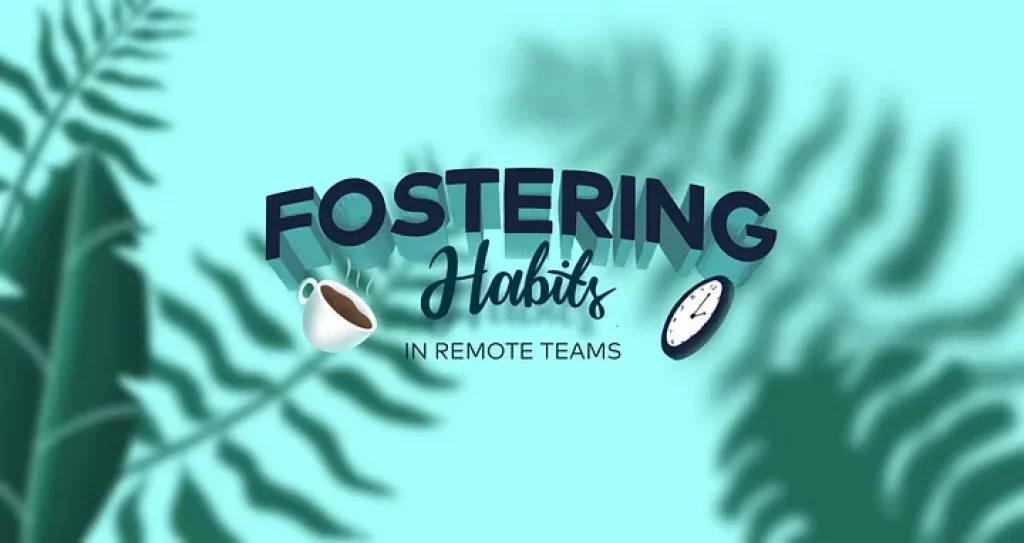Fostering habits in remote teams

Most of what we do from day to day can be linked back to habits.
For example, I have my alarm clock go off at 6:00AM, this gives me a chance to wake up and get ready for work. When the weekend comes and I have a chance to have a lie in, as there are no commitments the next day, guess what time I generally wake up?
Around 6:00AM.
This is because waking up at that time has become a habit and a weekend off isn’t enough to change that (more’s the pity).
The same can be said for a lot of things.
But why are we talking about my waking arrangements?
Simple, habits are an important part of how we operate, 40% of our daily activities are habits.
Having these habits can ensure that we’re up in time for work (see it was relevant), that we set aside enough time to accomplish tasks within deadlines and so on.
Some habits we work on and build ourselves, some can be impressed upon us, for a manager, this can be a useful tool to have in your arsenal.
You can use this to help foster habits in your team, whether it’s adding a new process into their daily routines (e.g. create a to-do list each morning), or get them to start using a new app, this helps build adoption.
You want these to become second nature so that your team do them automatically. But they don’t simply build overnight, there are a few things you need to do.
Repeat, repeat, repeat
One of the most important parts of forming a habit is repetition, by getting your team to perform an action, again and again.
This helps ingrain the action/habit into your teams subconscious. When trying to get your team to adopt a new habit, you need to enforce this repetition to the point where it seems redundant.
However, the likelihood is that you’re not simply going to get all of your team into the mindest to keep repeating the habit out of nowhere.
It’s going to take a little push, which brings us to.
Use cues and prompts
Habits don’t simply happen out of thin air, they can take some time to build up and get used to.
Employees aren’t going to suddenly start using/doing something that they are not accustomed to, they won’t open an app they don’t normally use, they aren’t going to create a to-do list at the beginning of each day at the drop of a hat.
They have other responsibilities to consider and something newly introduced isn’t necessarily going to stick straight away.
The habit needs to be triggered. A study found that to form a habit, there needs to be:
Context — By performing a task within the same circumstances, can help it become a habit.
Reward — It’s important to understand why what you’re team is (trying) to become a habit is important. How it helps, the benefits it brings.
Sequences — habits can be part of a sequence that triggers other habits, helping to build a chain of habits.
It’s not enough to tell your team to start doing something, they need to be trained to respond with the new habit in a specific context. When trying to introduce a new tool for them to use for example, it’s important to tell your team why, how it’s important and how it helps.
Then, you want to introduce a trigger, so for your team to write their to-do list, have them set 10 minutes aside first thing in the morning to write it.
You can tie it into an existing habit, for example, if you have a new video conferecing tool, get them to use the new video calling app (new habit), for your weekly team catchups (existing habit).
Outside of that, you might need to provide a little reminder from time to time. This could be something as simple as pinging a quick reminder via Slack to mentioning it to everyone at the end of your weekly meetings.
Which brings us to our final point.
Make the change small
It’s about taking baby steps, put something too big to your team, you may overwhelm them and fail to maintain uptake. It takes motivation to get your employees into the new habit and the more it takes, the more difficult it is.
As a manager, you have limited control over your team’s motivation, much of that comes internally, from their own desire to from the habit. So, the change needs to be small enough so it’s easy to incorporate into their routine.
You see, smaller habits are stored in a different part of the brain than other habits. They are stored in the basal ganglia, which is directly linked to muscle control, posture, and, oddly enough, cursing.
Some examples of keeping the habit small might be:
Rather than having employees create a multi-point to-do list for their workday, have them set a singular goal to complete that day.
If you’re getting them to use a new app or system, instead of introducing them to everything it can do, try teaching them to use one features. They can then be taught the others at a later time, or even from exploring the app on their own.
With these tips, you this should make it easier to introduce new methods or tools to your team.
How do you get your team to start new habits? Let us know in the comments.



 Form the Blog
Form the Blog